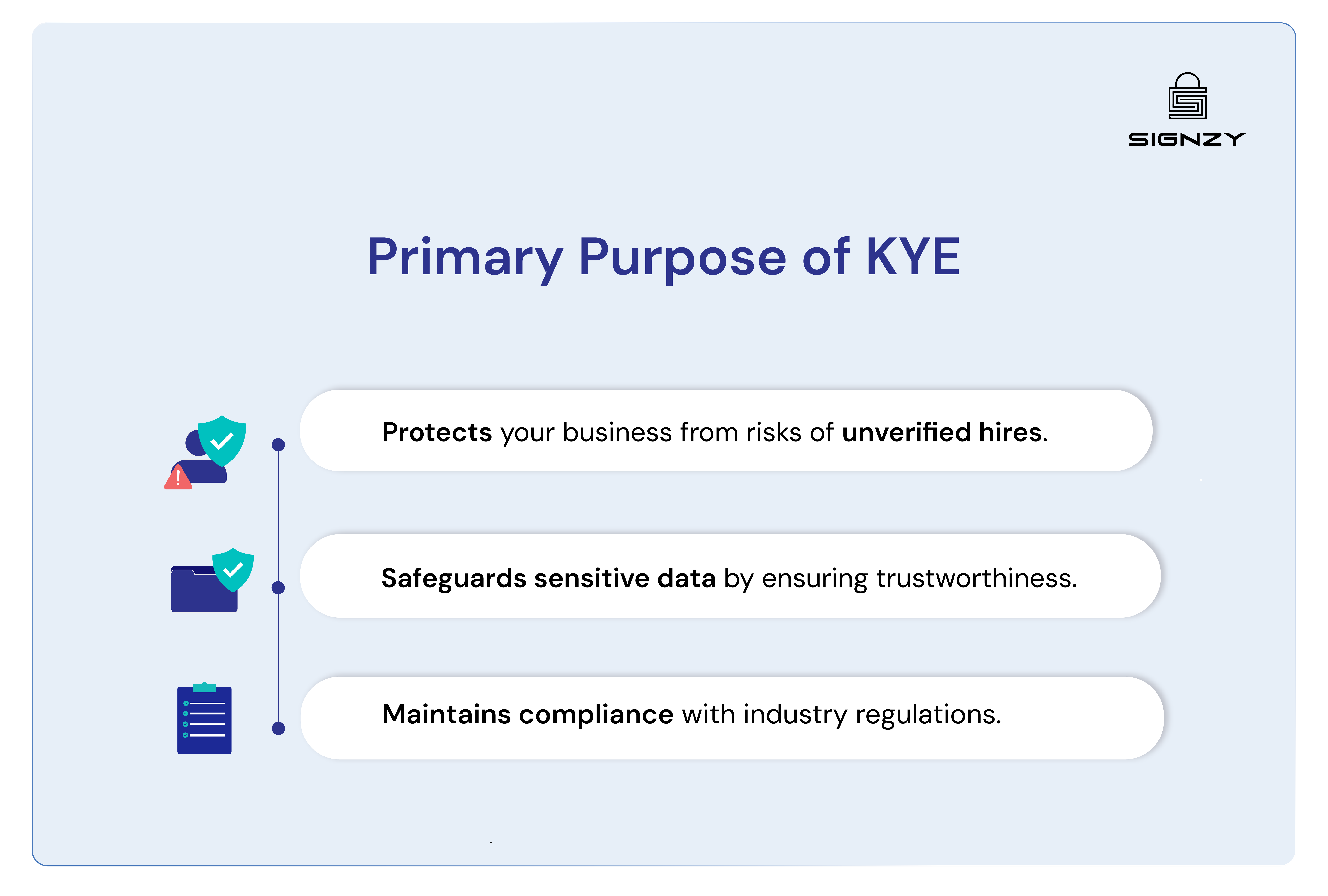Know Your Employee – Business Protection Guide 2025
- As per Occupational Fraud 2022 report, more than 85% of employee fraud cases showed warning signs before any damage was done. That’s right – proper verification could have spotted these issues early on.
- 57% of all fraud cases involve either internal employees or a combination of internal staff working with outside perpetrators.
- Job-related scams increased by 250% between 2022 and 2023, revealing a significant rise in employment fraud schemes.
Ever noticed how casino dealers change shifts? There’s a precise ritual: showing empty pockets, turning their palms to cameras, following specific exit paths. Even their breaks are timed and tracked.
You might wonder what this has to do with your business.
But consider this: if establishments dealing with physical chips take such careful measures to verify their employees, what about organizations handling sensitive data, customer information, and digital assets that are worth far more?
The reality is that trust, while essential, needs verification – especially when it comes to who has access to your business’s critical resources.
A resume, a quick call, maybe a short reference check provided by them. But is that enough?
If you don’t think so, this guide has everything for you. Takes 6 minutes and can save some hours at least, if not days.
Let’s start right away.
Definition of Know Your Employee (KYE)
Know Your Employee (KYE) is your organization’s systematic way to verify and monitor who’s really working for you, what they’re qualified to do, and whether they can be trusted with sensitive information. It doesn’t ask you to be overly suspicious, but it does ask you to be sensibly careful with your business’s future, as running a successful business often comes down to having the right people on your team.
💡 Related Blog:
Purpose of KYE
Think about what matters most to your business – its reputation, security, and the trust of your customers. This is exactly what Know Your Employee (KYE) helps protect. While many see KYE as just another compliance requirement, its true purpose runs much deeper.

KYE’s primary purpose is threefold:
- It helps protect your business from potential threats that could arise from hiring individuals without proper verification.
- It safeguards your sensitive business data by ensuring only trustworthy individuals have access.
- It helps maintain compliance with regulatory requirements that govern your industry.
For instance, hiring individuals who are unauthorized to work in the US, or have criminal records or falsified qualifications, especially in sensitive positions, exposes your business to significant legal action. KYE helps prevent these situations through thorough verification processes. It’s particularly crucial when employees handle confidential information or have access to financial systems.
If you’re running a bank or any financial institution, you even need extra eyes. Section 19 of the Federal Deposit Insurance (FDI) Act makes it clear that you must perform criminal background checks on all applicants.
The law prohibits explicitly hiring anyone with a record of dishonesty, breach of trust, or money laundering. This includes individuals who’ve entered pre-trial conversion agreements related to these offenses.
Risks of Not Implementing KYE
Now, let’s see what is at stake when KYE isn’t part of your business strategy. While some organizations might view KYE as optional, the consequences of skipping these vital checks can be severe – and often costly.
While there are many, here are five major ones which you must be aware of:
- Internal Security Breaches: When you don’t correctly verify who’s working for you, your business becomes an easy target for internal threats. We’re talking about employees accessing systems they shouldn’t, taking sensitive data, or misusing company finances. Even one person with the wrong intentions can cause serious damage, especially when they have access to financial records or customer information.
- Operational Integrity Risks: What happens when you discover someone’s qualifications aren’t real? Every project they’ve touched on needs review, clients need to be informed, and work might need to be redone. This can disrupt your entire operation and put your reputation on the line.
- Information Security Vulnerabilities: Poor verification creates security weak spots throughout your organization. Beyond just data breaches, you’re risking your intellectual property and customer information. For regulated industries, you’ll need to report these breaches and face investigations – not to mention explain to your customers what went wrong.
- Legal Liability Exposure: When someone with an undisclosed criminal history causes problems at work, your organization bears the responsibility. You’re looking at potential lawsuits, settlement costs, and higher insurance rates – all because of insufficient initial checking.
- Client Trust Deterioration: Once clients learn about employee-related incidents, rebuilding trust becomes a major challenge. You’ll need to notify them about what happened, review your services, and prove you’ve fixed the problems. This process takes time, money and often requires outside auditors to verify your new procedures.
And sadly, these risks don’t exist in isolation – they tend to create a domino effect.
But here’s the good news: you can prevent most of these issues with proper KYE systems in place. Create one for your business following these 6 steps.
Related Resources
6 Steps to Conduct KYE in Business
Let’s walk through the practical steps of creating a KYE system that really works for your business.
Step 1: Initial Information Collection
Before anything, you need some information to work on. Here’s exactly what you’ll need to gather from the start:
- Government-issued identification (passport, driver’s license, social security number)
- Complete employment history with specific dates and contacts
- Educational transcripts directly from institutions
- Professional certifications with verification contacts
- Professional references with current contact information
Once done collecting, it’s time to verify these.
Step 2: Document Verification Process
Now, this is where attention to detail really matters. When you’re checking those government IDs, you’ll want to look closely at security features and expiration dates. Don’t just accept copies at face value. Instead, reach out directly to issuing institutions to confirm certifications and credentials.
As stated earlier, if you’re in financial services, you’ll need to pay extra attention here – the FDI Act requirements are pretty specific about checking for any history of financial crimes or breach of trust. Even if you’re in another industry, these thorough checks help protect your business from potential issues down the road.
Step 3: Background Screening
In this step, you need to ensure three main things:
- The employee is authorized to work in the US (first and foremost)
- The employee has communicated any criminal history early on (get clarification if needed)
- The employee is not being dishonest and has provided actual documents and credentials
Also, make sure you screen employees in the context of your business. For example, when you’re filling financial positions, you’ll definitely want those credit checks and financial history verifications. And if you’re in healthcare? Well, those medical credentials need extra scrutiny, and you’ll want to check for any history of professional misconduct.
Step 4: Ongoing Monitoring
Think of it this way – you wouldn’t set up a security system and never check if it’s working, right? The same goes for KYE. You’ll want to review access privileges regularly, make sure professional credentials stay current, and keep an eye on those system access logs. When something seems off, you’ll want to know right away.
Step 5: Security Protocols
Make sure your process is thorough but not overwhelming. Start with role-based access control – basically, making sure people can only access what they need for their job. Then, add multi-factor authentication for sensitive areas (it’s worth the extra step). Remember to keep your team in the loop with regular security training.
Step 6: Record Management
Now, keeping good records might not sound exciting, but it’s absolutely crucial. Think of it as your safety net – every verification you complete, every background check result, and every security clearance update needs to be documented. Because when questions come up (and they will), you’ll want clear evidence of your due diligence.
The best part? When you get these components working together, you’re not just checking boxes – you’re building a secure foundation for your business to grow.
Next Steps
After understanding how KYE contributes to your organization’s security and success, the next step is implementing these verification processes effectively. Our identity verification and SSN validation services help streamline this crucial aspect of KYE. You get to focus on building your team while we handle the thorough verification processes you’ve learned about.
FAQ
What's the difference between KYC and KYE?
Are KYE processes different for remote employees?
What documents are mandatory for KYE verification?
Can small businesses implement effective KYE programs?

Tanya Narayan
Tanya is a Product Marketing Manager at Signzy and a GrowthX Fellow, with a strong focus on SaaS and fintech. She specializes in go-to-market strategy, customer research, and positioning to help teams bring products to market effectively. She has also cleared the Company Secretary foundation level, reflecting her grounding in corporate and compliance fundamentals.


